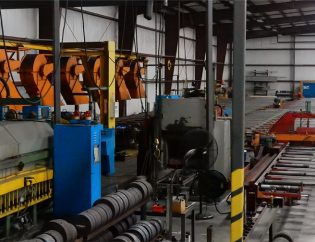Aluminum extrusion is a process that involves forcing an aluminum billet that has been preheated through a die that has the profile of a part or component. The shapes produced by aluminum extrusion are solid parts without voids, hollow parts with voids, and semi-hollow parts with enclosed voids. The process is used to produce a wide variety of products for architectural designs, automotive construction, electronics, aerospace, and the energy industry.
Tempering Hardness of Aluminum Extrusions
Extruded aluminum can be enhanced using any number of methods, including the addition of alloys or work hardening. Of the various methods, the most popular is tempering, which is used to alter the mechanical properties of extruded aluminum components. Tempering has pronounced effects on an aluminum alloy’s appearance and mechanical properties, factors that necessitate a clear understanding of the types and levels of tempering.
All aluminum alloys are identified using a four-digit number and are divided into heat treatable alloys and non-heat treatable alloys. Aluminum series 1000, 3000, and 5000 are series families that are non-heat treatable while series 2000, 6000, and 7000 are heat treatable and can be tempered. An aluminum alloy that has been heated treated is identified by its four-digit series number followed by a heat treatment T tempering code, such as 6061-T6.
The five types of tempering are identified by the letters F, O, H, W, and T. Each letter is a short descriptor for a type of tempering with F for fabrication, O for annealing, H for strain hardening, W for solution heat treatment, and T for thermal treatment. Of the five types of tempering, T, thermal treatment, is the most common and can be identified by up to five digits with each digit or combination of digits indicating a portion of the tempering process.
In the T category of tempering, there are ten subcategories that describe how and to what extent an aluminum alloy is heated and how the alloy is aged. The three common types of tempering are T4, T5, and T6, which are divided by how the aluminum alloy is aged.
When the tempering process is identified as T6, it means the aluminum alloy has been solution heat treated followed by quenching, cooling, and artificial aging, a process that allows the metal to reach precipitation hardening. For the tempering of aluminum 6061-T6, an aluminum alloy billet 6061-O is heated to 900°F (482°C) and is water quenched and aged at a low temperature for several hours. To achieve T6 tempering, the cooling rate must be greater than or equal to 41°C per minute for alloy 6063, 62°C per minute for alloy 6005, and 142°C per minute for alloy 6061. The application of T6 to aluminum 6061 quadruples its yield strength from 8000 psi to 35000 psi (8 ksi to 35 ksi).
The T4 tempering process is a solution heat treatment where the aluminum alloy is heated to 1050°F (566°C) and quenched to hold the alloying elements. Once a T4 aluminum alloy is quenched, it will naturally age at room temperature, slowly increasing the tensile and yield strength of the alloy, a process that can take two to three weeks.The wide use of T5 aluminum tempering is due to its low cost and ease of processing. The T5 process involves heating the aluminum alloy to 932°F (500°C) after which it is very slowly cooled. Slow cooling allows for the formation of a uniform grain structure to give an alloy formability and improved corrosion resistance.
Load Bearing of Tempered Parts
The process of tempering increases the tensile strength and yield strength of aluminum. With aluminum alloy 6005-T5, extruded profiles have a tensile strength of 37,700 psi with a yield strength of 34,800 psi. Aluminum alloy 6061-T6, when extruded, has a tensile strength of 45,000 psi with a yield strength of 40,000 psi. Increased strength can be found in 6063-T6, which has a tensile strength of 35,000 psi and yield strength of 31,000 psi. In all cases, the strength to weight ratio of tempered aluminum alloys is comparable to that of steel.
When discussing the uses of tempered aluminum, there is always a comparison between aluminum and steel, since steel is considered to be the strongest metal. There is a wide range of aluminum and steel alloys with each type of alloy having their own load capacities, tensile strengths, and yield strengths. If we take one steel alloy, such as A36, and one aluminum alloy, such as alloy 6061-T6, the aluminum alloy is as strong as steel A36 but is lighter and easier to use.
The properties of aluminum extrusions and their characteristics make them ideal materials for a wide range of applications. The general interpretation of aluminum is that it is a lightweight metal that can only be used for non-load bearing applications. The long list of aluminum alloys contains metals that are used in every type of industrial and manufacturing operation. Properly treated, conditioned, and engineered aluminum is capable of providing support for buildings, airplanes, and automobiles as well as the frames for household appliances.
Common 6000 Series Aluminum Alloys
The 6000 series of aluminum alloys contain magnesium and silicon, which makes the series of alloys heat treatable. The alloys of the 6000 series are the most widely used and versatile of the different aluminum alloy families. The properties of 6000 alloys include extrudability, exceptional strength, and the highest corrosion resistance of all of the aluminum alloys. Extruded 6000 series alloys are commonly used for building structure supports and architectural applications. The most popular and widely used of the 6000 series are alloys 6005, 6061, and 6063.
6005 and 6005A Alloys
The key element in alloy 6005 is silicon, which radically reduces its melting point and improves its extrudability. Alloy 6005A differs from 6005 in that it contains a percentage of chromium and an increased amount of magnesium, which increases its strength. Both alloys can be welded or brazed and are resistant to corrosion and respond well to anodizing to create a clear hard coat finish. Alloys 6005 and 6005A are extruded to make tubing, parts for busses, piping, and parts for marine applications.
6061 Alloy
Alloy 6061 is widely used due to its toughness and being the most heat treatable of the 6000 series of alloys. The magnesium and silicon content of alloy 6061 gives it increased corrosion resistance, easy machinability, and weldability. The flexibility of 6061 can be seen in the varied ways that it is used, such as material for fishing rods and components for aircraft and automobiles. As an adaptable and easy to use alloy, 6061 is sold in many forms, with extruded 6061 being the most common form. Aluminum alloy 6061-T6 has strength that is comparable to many steels.
6063 Alloy
Since alloy 6063 has a lower magnesium and silicon content, it is not as strong as alloy 6061, which makes it suitable for applications where strength is not an issue but an appealing surface finish is important. Alloy 6063 is widely used for decorative purposes due to its extraordinarily pleasing appearance. As with alloy 6061, alloy 6063 is a popular alloy for extrusion. Unlike alloy 6061, alloy 6063 is easier to extrude into complex, intricate configurations and shapes.
Quality Stamping & Tube (QST)
Quality Stamping & Tube is a world leader in the extrusion of high-quality parts and components. Over the years, the company has expanded its operations to include a wide range of metal manufacturing processes with the extrusion of aluminum being one of its core processes. For all your metal manufacturing needs, contact QST at 262 677 5100 or visit QST website https://qst-corp.com/contact.
Ready to get your project started?
Contact QST today for a free quote!




